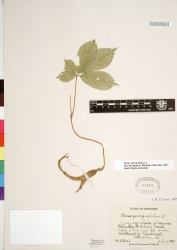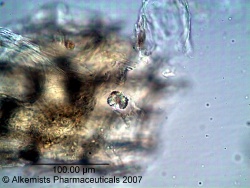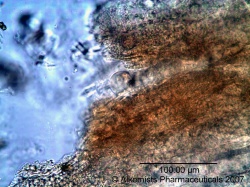Panax quinquefolius (root)
From AHPA Botanical Identity References Compendium
(Difference between revisions)
(add USD 1918 information (organoleptic and macroscopic)) |
(add macro characteristics) |
||
| Line 34: | Line 34: | ||
{| border=1 | {| border=1 | ||
| | | | ||
| + | {{Macroscopy | source=American Medicinal Plants of Commercial Importance (1930) | ||
| + | | description=Ginseng is an erect plant growing from 8 to 15 inches high and bearing three leaves at the summit, each leaf consisting of five thin, stalked leaflets. The three upper leaflets are larger than the two lower ones. From 6 to 20 greenish-yellow flowers are produced in a small cluster during July and August, followed later in the season by bright-crimson berries. Ginseng has a thick, fleshy, spindle-shaped root 2 to 3 inches or more in length and about one-half to 1 inch in thickness, often branched. After the second year the root becomes branched or forked. | ||
| + | }} | ||
{{Macroscopy | source=United States Dispensatory (1918) | {{Macroscopy | source=United States Dispensatory (1918) | ||
| description=The root is fleshy, somewhat spindle-shaped, from 5 to 12 cm. long, and 1 to 2.5 cm. thick, and terminated by one or more stem scars. Frequently there are two portions, sometimes three or more, connected at their upper extremity, and bearing a supposed, though very remote, resemblance to the human figure, from which circumstance it is said that the Chinese name ginseng originated. When dried, the root is yellowish-white and wrinkled externally, and within consists usually of a hard central portion, surrounded by a soft whitish bark. }} | | description=The root is fleshy, somewhat spindle-shaped, from 5 to 12 cm. long, and 1 to 2.5 cm. thick, and terminated by one or more stem scars. Frequently there are two portions, sometimes three or more, connected at their upper extremity, and bearing a supposed, though very remote, resemblance to the human figure, from which circumstance it is said that the Chinese name ginseng originated. When dried, the root is yellowish-white and wrinkled externally, and within consists usually of a hard central portion, surrounded by a soft whitish bark. }} | ||
Latest revision as of 20:55, 16 June 2015
Contents |
Nomenclature
Panax quinquefolius L. Araliaceae
Standardized common name (English): American ginseng
Pinyin name(s): xi yang shen (root)
Botanical Voucher Specimen
|
|
Organoleptic Characteristics
|
Macroscopic Characteristics
|
Microscopic Characteristics
 |
 |
|
|
|
High Performance Thin Layer Chromatographic Identification
Supplementary Information
Sources
- ↑ MOBOT, Tropicos.org http://www.tropicos.org/Image/53111
- ↑ United States Dispensatory (1918)
- ↑ American Medicinal Plants of Commercial Importance (1930)
- ↑ United States Dispensatory (1918)
- ↑ Elan M. Sudberg, Alkemist Laboratories http://www.alkemist.com
- ↑ Elan M. Sudberg, Alkemist Laboratories http://www.alkemist.com


